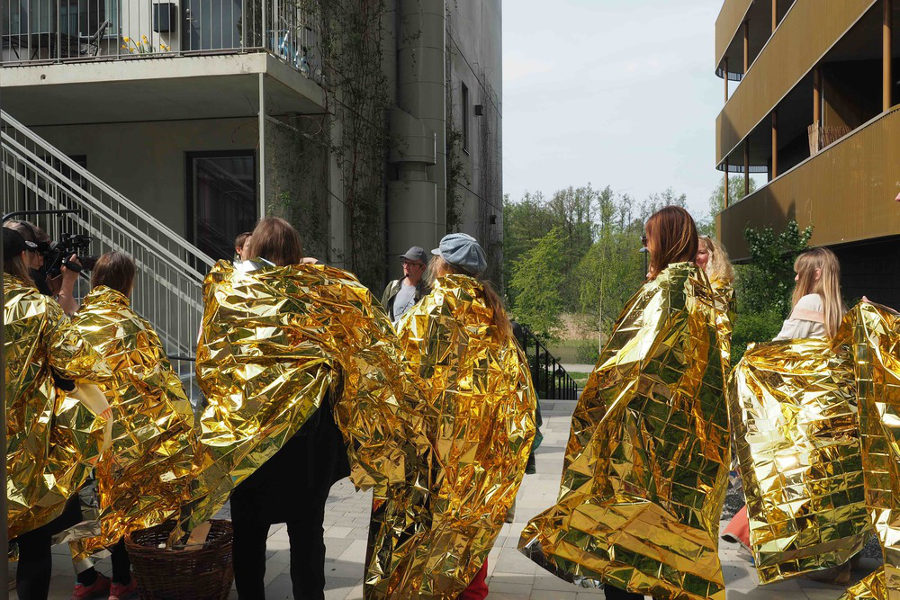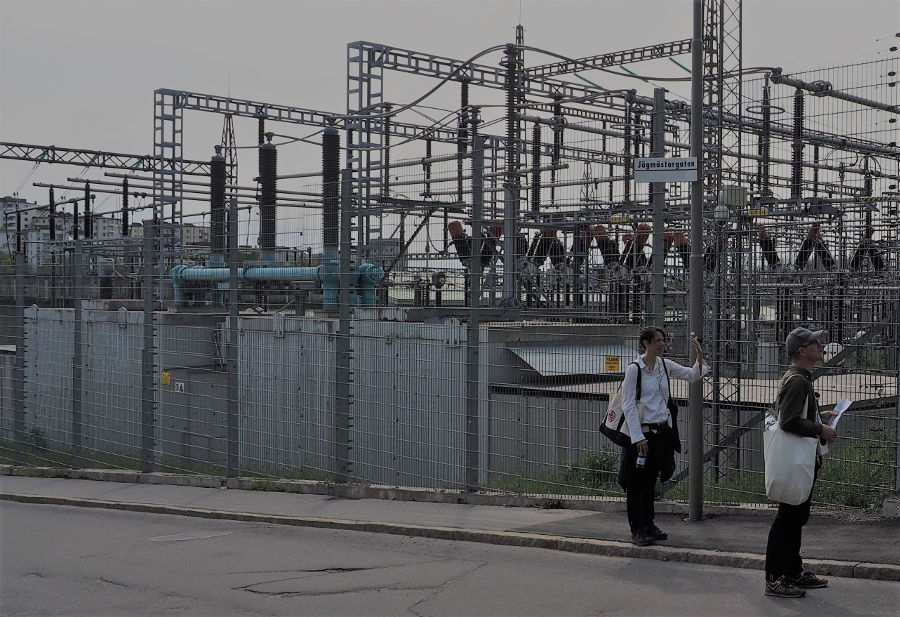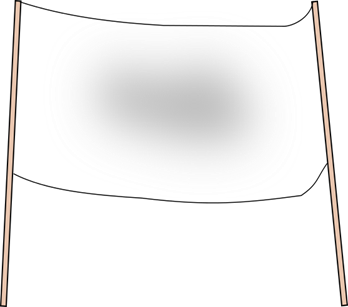NIS
RØMER
Artist,
educator & curator
News
CV & contact
Teaching
Curating
Press
PROJECTS
Plant Parliament
The Dark Reaction
Golden Standard
Holistic masterplan Haninge
Møn Land Reform
Revenge of the Crystals
Model Society
Communities of Desire
Garden of Commons
Plant Nursery
Imaginistic Welfare Institute
Hallucinogenic Parks
Workarounds
Migrating Gardens
Hans Blix' Glasses
SOUP Rooftop Garden
Free Soil Bus Tour
Public Air Quality Indicator
GROUPS
Walking Distance/ Gåafstand
Field Work
Publik
Free Soil
ARCHIVE
See more works
PUBLIC LIBRARY
Some rare and out of print books
A performative walk and narration at Hjorthagen, Stockholm with Pia Rönicke/ Walking Distance
For an exhibition by Mossutstallningar
The Golden Standard is a meteorological Sci Fi performed by us and the participants wearing heat blankets during the walk.

We speculated on ways of building in the future, below a quote:
"The philosophy is basically that materials cannot be owned, but are merely something we have on loan from nature. In a moment we will reach the edge of the disassembly zone. There we will see the carefully dismantling of houses, and sorting of building materials. Everything will be taken apart and moved to higher ground to be used again."
Above a high-level water mark on a bench.
"The frequency of flooding in these lands have become to high for human occupation. And we, as many others, will have to evacuate to the hills. For everyone there is a blanket to keep you warm and protected in the process. This is a transitory skin, a second architecture, that reflects heat back on your body, and ironically reflects the image of the architecture being disassembled around you in a golden glow. We are in transition. Only a µ thin skin to protect us from the all to frequent bursts of rain, it also reflects the unfiltered sun rays, and deflects the sudden colds."

"You will see rabbits everywhere grazing behind the fence. Shortage of foods made rabbits the most popular home breeding animal. They are all runaway animals (probably let free by kids who were to fund of the animals to eat them for dinner)"

"Listen: It is no longer electricity you hear, but the humming from the Ocean. The Ocean comes to us as a warning, but also as a reminder, to live in accordance with the elements."
Manuscript below:
The
Golden Standard
Welcome to this walk titled
The Golden Standard. We are Pia Rönicke and Nis Rømer and we
are a part of Gåafstand. Gåafstand is a
walking group that collectively explores our environment and state of mind
through the lenses of art and urban planning. We ask you to take part, but don’t do anything that
you don’t feel comfortable with, the walk lasts 45 minutes. We will end up by
the Ropsten T-bana.
You will take part in a sci-fi
walk that slowly ventures back in time from a future perspective. We start by
looking at The Golden Standard of the new parts of Hjorthagen.
The Golden Standard for
building materials, was adapted in some parts of the building industry
as early as 2015. The public sector was a driver for this process, but
initially companies also joined when realising there was a strong business
case. This is very much to our luck today in 2055. As you might know, The Golden
Standard means that no building materials that come from nature can be mixed in
a way so that they cannot be separated again to be reused without loss of
quality. The philosophy is basically that materials cannot be owned, but are
merely something we have on loan from nature. In a moment we will reach the
edge of the disassembly zone. There we will see the careful dismantling of
houses, and sorting of building materials. Everything will be taken apart and
moved to higher ground to be used again. Disassembler was, on a side note, one
of the most common occupations last year.
The Golden Standard takes a
lot of things into consideration. It only allows for the best. This city was
built with the best material. Look closer and what do you see? Every surface is
different. The eye doesn’t get bored. But it also lets us know that there is a
difference between rich and poor, beautiful surfaces don’t come cheap.
All this because of the
floods. The frequency of flooding in these lands has become too high for human
occupation. And we, like many others, will have to evacuate to the hills. For
everyone there is a blanket to keep you warm and protected in the process. This
is a transitory skin, a second architecture, that reflects heat back onto your
body, and ironically reflects the image of the architecture being disassembled all
around you with a golden glow. We are in transition. Only a micrometre-thin
skin to protect us from the all-too-frequent bursts of rain, it also reflects
the unfiltered sun rays, and deflects the sudden colds. Please wrap the blanket
around you - gold side out and stick together. Please follow us the last bit of
the journey.
PR:
Housing prices anno 2019
As you might know these
housing estates was built on public land. Half of it was sold by the City of
Stockholm (in order to invest in the infrastructure) and bought up by large
construction and property companies. Half of the housing was set aside for rental
apartments (my note says that you could rent an 80m2 apartment for a
minumum 18,000 SEK a month) whereas the other half was sold as housing
cooperative apartments for very high prices. 83 m2 with canal view
for 7,500,000 SEK, and at the more modest end was an inner yard apartment, 70 m2
for around 5,500,000 SEK. This is, of course, without importance now, but
imagine where that money went after the flood.
These parts of the city are
the next to be disassembled. But do note how The Golden Standard is applied to
the textures of the buildings.
PR: Look
here, it reminds us of Potsdamer Platz... [Notes the buildings by café Tre
Bönor]
Don’t you agree... the colours,
the built-in balconies... the German influence is unmistakeable. The irony in
this is, of course, that Potsdamer Platz was rebuilt so many years after the Second
World War, this part will be disassembled in a quicker fashion.
NR: Meteorological
fictions [note while passing the old gas works]
The most popular genre in
literature in the 2040s was climate fiction or cli-fi. Meteorological data and
forecasts were bent and reimagined. These huge containers were at one point
rebuilt to store large quantities of greenhouse gasses. Eventually the
method was abandoned, and they now have mostly historical and cultural value.
(The Gasworks (Värtagasverket) by architect Ferdinande Boberg was buildt in 1893. At the time considered the world’s largest gas containers with a volume of 65 000 cubic metres, It was abandoned in 2011 when Stockholm switched to natural- and biogas.)

NR: Global
Climate Ministry [note while passing the old gas works]
The UN made the entire atmosphere
into a protected entity. This meant that nothing could enter into the
atmosphere through human actions that was not compensated for in another way.
This had historic precedence: In the 1980s, the oceans were seen as endless
entities into which human waste and by-products could be dumped, even radioactive
waste. This was eventually banned. During the 2020s a new perception dawned
that the air that we breathe is what connects us all mentally and physically. The
atmosphere is not endless either. And by 2030 the atmosphere was actively
protected and legislation was enforced by the Central Climate Ministry, with the
power to close down a country’s power sources if they were in excess of
predefined levels. Creative climate accounting was put on par with economic
crimes.
PR: Higher
Grounds [going up the path + going through the fence]
We will enter through one
of the new paths being formed; the raising of the sea necessitates new
infrastructure, not everything can be planned. This one still needs
consolidation. You might see traces of people who have been “camping on the
hillside” overlooking the floods.
Please come through the
fence everybody, be careful not to hurt yourself. Feel free to relieve yourself
of the golden blanket, you are now safe and out of the distressed zone, or keep
it on if it feels comfortable.
We have now entered another time zone. Or should we say a gap in time. We have left the future and have not yet entered the past. This gap in time gives us perspective. Please get a sense of where you are, feel the ground, touch the earth, open your nostrils. It is important that we connect with our senses in order to make this journey. For too long we have left our senses behind, for too long we allowed the elements of earth, water, fire and air to be misused. It is time to reconnect. And the only way we can do this is through a presence, in this time gap of the here and now. Stand still for a second, attune yourself. Take in the colours of the leaves, look at what is here. Is there something we can reuse for new purposes?
Functionalist
housing [Note on the housing estate Abessinien]
We want to tell you a
little about this estate. Some of you might know much more than us, please don’t
hesitate to give us your story. But for those of you who don’t know these
famous buildings, we will give you a context.
These houses were heavily
inspired by the functionalist movement of Bauhaus. I will read aloud an excerpt
from the Marxist Bauhaus director Hannes Meyer, from his manifesto of 1929, Bauhaus
and Society
Give
proper embodiment
Appropriate
to living
Be
servants of this community
Growing
means
Striving
after the harmonious enjoyment of
Oxygen+carbon+sugar+starch+protein
Work
means
Our
search for the harmonious form of existence
We
despise every form
Which
is prostituted into a formula
It is
the song of songs of harmony
It is
a strategy for balancing within the community
Its
basis is the recognition of the living space
Finally
all creative action is determined by the fate
Of the
landscape
If a
floating population lacks these roots:
Abessinien (an unofficial
name coming from Mussolini’s war in Ethiopia, after the mess of the building site)
was built on the behalf of the workers in the area (members of the gasworks
workers club), on ground where there had been a forest and small, unoffical
allotment gardens. From the beginning, the City of Stockholm didn’t want to
either sell the land or build housing for the workers here. A committee was
formed and got in contact with the builder Olle Engkvist and the architect
Hakon Ahlberg. A model was shown at Liljevalchs konsthall. And a plan was formed
that made the apartments bigger than the original 36m2. The interest
in the apartments was very big, and both workers from the gasworks as well as
the power station signed up for them. Hjorthagen’s people’s house and
the tenant organisation Hjorthagshus were established in 1934 and made
the plans come true (with a loan from the forsäkringsanstalten Folket).
In 1935, 354 apartments were ready, half of them two-room apartments of 44m2
and the other half 40m2 of one room with an alcove. All apartments
had a hip bath, central heating, garbage chutes and laundry room. Heating in
the first ten years was from coke and firewood, after that with oil. Rent was
850–870 SEK a year for two rooms and 775–795 SEK for one room, depending on the
location.
NR: Abandoned
power plant
This is what caused it all.
The burning of coal. Värtaverket from 1903, designed by Ferdinand Boberg. In
2016, this plant was supplemented by a new plant that used biological fuels in the
form of sawdust and biological waste. You might wonder why is it better to burn
trees than coal and oil? It is all about accounting; we are not using the Earth’s
savings from prehistoric times, but sources that can be renewed in our
lifetimes by planting an equal number of trees. The actual carbon dioxide emission
from this plant is the same, or bigger than before because energy consumption
soared in the 2020s and 2030s. In 2030 this type of accounting was made illegal
under the UN Atmosphere Protection Act.
NR: Listen…… you can still hear the humming from
electricity. You will see rabbits everywhere grazing behind the fence. Shortage
of food made rabbits the most popular home breeding animal. They are all
runaway animals (probably let free by kids who were too fond of the animals to
eat them for dinner)
PR: Listen, It is no longer electricity you hear, but
the humming of the ocean. The ocean comes to us as a warning, but also as a
reminder, to live in accordance with the elements.
— Searoad, Ursula K.
Le Guin.
NR: Listen again….., the sound of footsteps on
gravel. This is the sound of the world to come. Only materials that allow for
water to drain away naturally are allowed since the sewage system broke down
from the pressure of extreme weather. Personally, I really appreciate the
sound. It brings a kind of calm, and brings back a connection to the soil that
was lost physically and mentally, since… since the industrial revolution.
We’ll now enter our new
camp/habitat. Some compare it to the time in the 1940s, just after the Second
World War. There was scarcity. Nothing could be sailed across oceans. Things
were being used and reused to their full extent. But unlike then, when it was
mainly about rebuilding the economy, now the way we shape the objects and
buildings that surround us holds higher importance. Materials are treated
better because of the Golden Standard. Ornaments are frequent, as is the
inherent beauty of natural materials. Artists once again became valued members
of the community for making the most of the little resources we have. You see
backyard farming and chickens are all around us.
PR:
Gula Husen (Yellow houses)
Was built by the City of
Stockholm between 1909–1910 for the workers at the gasworks and the power station.
Many of them working shifts, living further away (because of the expensive
rents in Östermalm), which made their commute difficult and tiresome. A number
of two-room apartments were built to heighten the standard of housing for
workers; with toilets, gas cookers and a laundry room in the basement (but no
electricity or central heating) All the apartments went through from back to
front. The architect was Frithiof Swensson (1873–1919). In total, 125
apartments, of which 99 had one room and a kitchen and 26 had two rooms and
kitchen.
Around the time of the
construction of the apartments there was a pine forest enclosing the housing, which
slowly succumbed to the pollution of the gasworks and the power station. The area had very bad air, which
was, of course, also a health risk for all living here. This makes the area so
different today.
Please settle down, have a
break.
Thanks for walking with us!
Further Images:

Society of Independent Cartographers